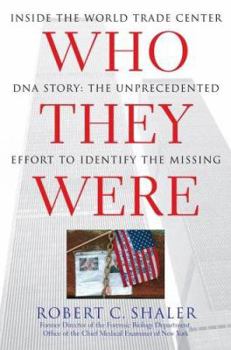Who They Were: Inside the World Trade Center DNA Story
Select Format
Select Condition 
Book Overview
In Who They Were, Dr. Robert C. Shaler, the man who directed the largest and most groundbreaking forensic DNA investigation in U.S. history, tells with poignant clarity and refreshing honesty the... This description may be from another edition of this product.
Format:Hardcover
Language:English
ISBN:0743275209
ISBN13:9780743275200
Release Date:October 2005
Publisher:Free Press
Length:370 Pages
Weight:1.25 lbs.
Dimensions:1.2" x 6.3" x 9.3"
Customer Reviews
2 ratings
Thenody for Bagpipes
Published by Thriftbooks.com User , 19 years ago
Once again, stalwart Free Press comes through with another incredibly in-depth, in fact slightly overlong, inquiry into recent history. In fact, given the subtance of the investigation, and its current limbo, this isn't really history at all, but reather current events of the most pressing nature. Who was it said that reading such and such a book was like holding lightning in your hands? Reading this book is like reading human blood. Dr. Shaler gives us a no hold barred accout of what it was like trying to deal with the innumerable scraps of human remains found at the site of the Weorld Trade Center disaster on September 11, 2001, in New York, and in the days, weeks and even months afterwards. Scientists and doctors, some who had never spoken to each other before, strangers, and some who were outright enemies, found themselves standing shoulder to shoulder trying to use forensics to fight back, fight against prejudice, fight against violence and terror and fight against the cloud of uncertainty by trying to match easch scrap, be it of brain or liver, with an actual human being believed to have died in the attacks. He even describes the chill with which his team came to understand that, even among the morass of human material, some of these body parts were probably those of the hijackers as well. It's not all high science either. Dr. Shaler has the vocabulary of an average New Yorker, and he is given to a descriptive obscenity when the drama of his story calls for it. '"Don't tell me we f--ked up the identification!" I said' is a typical comeback from him. But in general, the science is paramount and it helps us understand the complexity of the work involved. By and by the forensics scientists found themselves invited to the funerals of the vitims they had matched, through DNA or otherwise. The families were grateful. There must be a primitive urge to want to preserve the scraps of your own loved one's bodies, even miniscule ones, for there were funerals for mere fingers. Reminds me of the the way Catholic churches in my youth were erected around mere "relics" embedded in the tabernacles. Dr. Shaler's writing is simple and moving on such occasions, as though Hemingway had willed his genes to a top scientist and bureaucrat: "We stood around the grave site and waited. Soon, the bagpipers began playing and there was a short ceremony. The sun was shining and it was warm. I felt like I belonged."
Great book
Published by Thriftbooks.com User , 19 years ago
This book is a factual first hand account of Dr. Shaler's experience. The book contains detailed descriptions of the complete identification process from 911. I did enjoy learning about forensics. It also made me very proud to learn how the people in government handled this situation. The book includes the feelings and emotions from the long term commitment to assist with the critical identification process.





